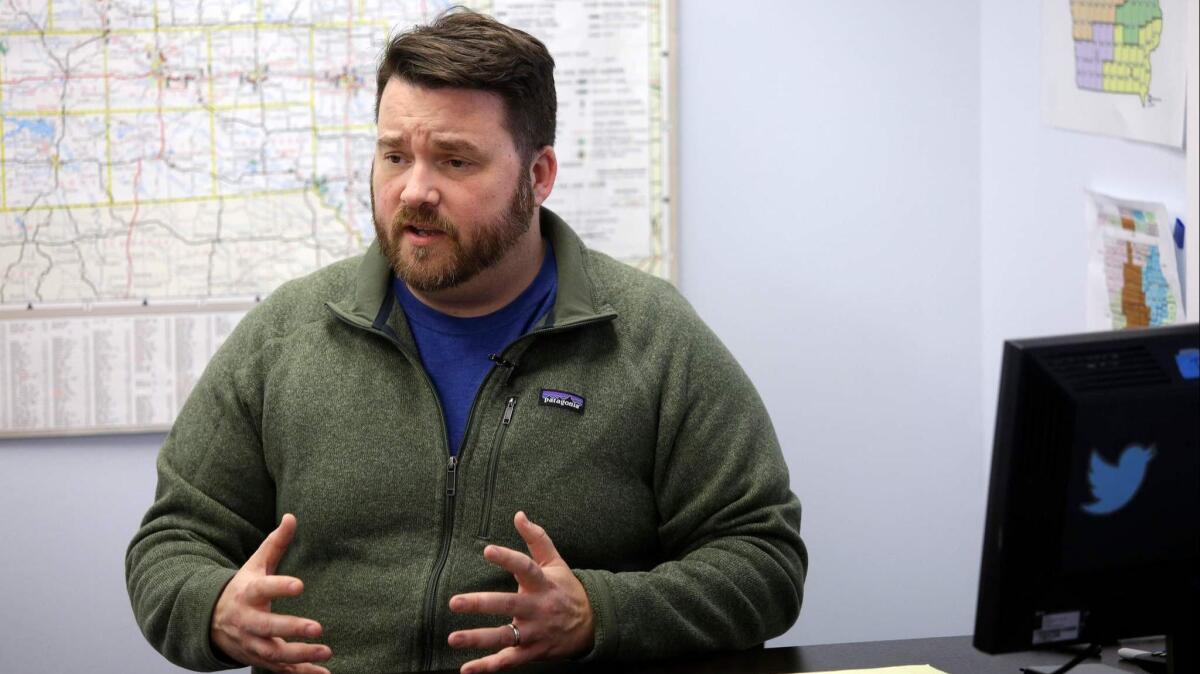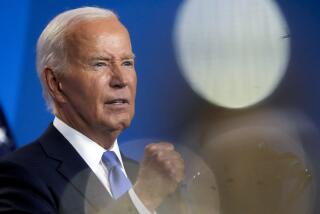Iowa is shaking things up, and the ripples may reach all the way to the White House

- Share via
Reporting from Des Moines — Iowa, that land of corn and political dreams, is planning big changes to its caucus system, and right about now you may be asking: What is a caucus and why should I care?
The answer is simple. The sentiments expressed by roughly a quarter-million or so Iowa Democrats on the first Monday night in February 2020 could go a long way toward shaping the fight for the party’s presidential nomination and, thus, who sits in the Oval Office come January 2021.
Other states, California being most notable, perennially complain about the inordinate influence Iowa enjoys as the state with the first say in the contest, attracting starry-eyed White House hopefuls the way Hollywood draws would-be movie stars.
But that political reality is not going to change anytime soon, even with California and other states moving their balloting up on the political calendar. So it can’t hurt to learn about things like “viability,” “realignment,” “state-level delegate equivalents” and the caucus overhaul planned for next winter.
So what is a caucus?
Essentially it’s a precinct-level gathering of party faithful that serves as the first step in a long, attenuated process that eventually results in the awarding of Iowa’s presidential delegates.
The original purpose was identifying and organizing party supporters at the grass-roots level so they could be deployed in political campaigns. A tally of presidential preferences was added just for fun.
But as the first official gauge of voter sentiment — after years of polling, speculation and incessant chatter — the caucuses have gained enormous import, mainly by culling the field to just a few viable contenders.
Who’s running for president and who’s not »
How do the caucuses work?
Up to now, the meetings were held at a set time. Participants were required to show up at one of 1,000-some locations, where supporters of each candidate broke into separate groups. If a candidate failed to meet a 15% “viability threshold,” his or her supporters had the choice of realigning — that is, backing another candidate — or calling it a night.
After the voting was completed, the party would report what were called “state delegate equivalents,” or the estimated number of delegates to the state party convention that a candidate would win based on their performance at the precinct level. The state convention is where Iowa’s national convention delegates are chosen.
My head’s starting to hurt.
Don’t worry. We track these things so you don’t have to.
It’s still all about beating expectations. What’s changed is the means to getting there.
— Dennis Goldford, Drake University political scientist and Iowa caucus expert
So what’s changing?
Most significantly, Democrats wishing to participate will no longer be required to show up at a caucus.
For years, critics have said the requirement was unfair to those unable to attend for any number of reasons: ill health, job requirements, child-care concerns. Hillary Clinton was among those who complained the loudest, suggesting her 2008 loss to Barack Obama stemmed, in part, from the limited caucus window. “There are a lot of people who work at night,” she said, “people who are on their feet, people who are taking care of patients in a hospital, or waiting on a table in a restaurant, or maybe in a patrol car keeping our streets safe.”
Under the new rules, Democrats may be able to back a preferred candidate by participating in one of six “virtual” caucuses, submitting a list of as many as five candidates, ranked by preference.
Kind of like “American Idol”?
The details remain to be worked out, not least concerns about security and ensuring the integrity of the vote. But, yes, participants may be able to weigh in via their smart phones while sitting on the couch watching cheesy television.
California’s presidential primary: Here’s what you need to know »
What are the other changes?
The rules governing the realignment process will be altered, limiting the movement between supporters of different candidates, in an effort to speed the caucuses along. (Another complaint is they take too long, dampening turnout.)
More important, the party will release the raw vote total each candidate receives, in addition to “state delegate equivalents,” in an effort to make the caucuses more transparent.
In 2016, Clinton just squeaked past Bernie Sanders, 49.8% to 49.6%, in the official results, which outraged supporters of the Vermont senator, who claimed a number of irregularities skewed the outcome. Some claim to this day he actually won the raw vote, but the count remains a mystery.
Why the changes now?
The national Democratic Party insisted on finding ways to make the caucuses more inclusive and less prone to controversy.
Iowans, in turn, wanted to preserve what state party Chairman Troy Price called the “spirit” of the caucuses, which is to say the neighbor-gathering-with neighbor aspect. (The virtual caucuses will be used to award a fraction, perhaps 10% or 15%, of delegates, to encourage folks to continue showing up.)
All of the changes are subject to revision and require the approval of both the state party Central Committee and the national Democratic Party. The goal is to have the new rules in place by fall.
So which candidates benefit and who will suffer as a result of the changes?
That’s a big unknown.
Participation could increase, maybe even topping the record 240,000 Democrats who showed up for the Clinton-Obama caucus-palooza. But it’s unclear who would gain the most from a higher turnout.
A great deal will depend on how the results are reported. Will the media focus on the winner of the raw vote, or the candidate who receives the most state delegate equivalents?
“It’s still all about beating expectations,” said Dennis Goldford, a Drake University political scientist and Iowa caucus expert. “What’s changed is the means to getting there.”
Huh?
“Winning” Iowa isn’t necessarily about coming in first. It’s about perceptions.
The best example may be 1984, when former Vice President Walter F. Mondale was preferred by nearly 50% of caucusgoers. The runner-up, Colorado Sen. Gary Hart, received just 16.5% support. But since that was better than expected, Hart was considered the winner and, literally overnight, became a serious contender for the Democratic nomination.
16.5% beats 48.9%? That’s nuts!
That’s Iowa.
More to Read
Get the L.A. Times Politics newsletter
Deeply reported insights into legislation, politics and policy from Sacramento, Washington and beyond. In your inbox three times per week.
You may occasionally receive promotional content from the Los Angeles Times.











